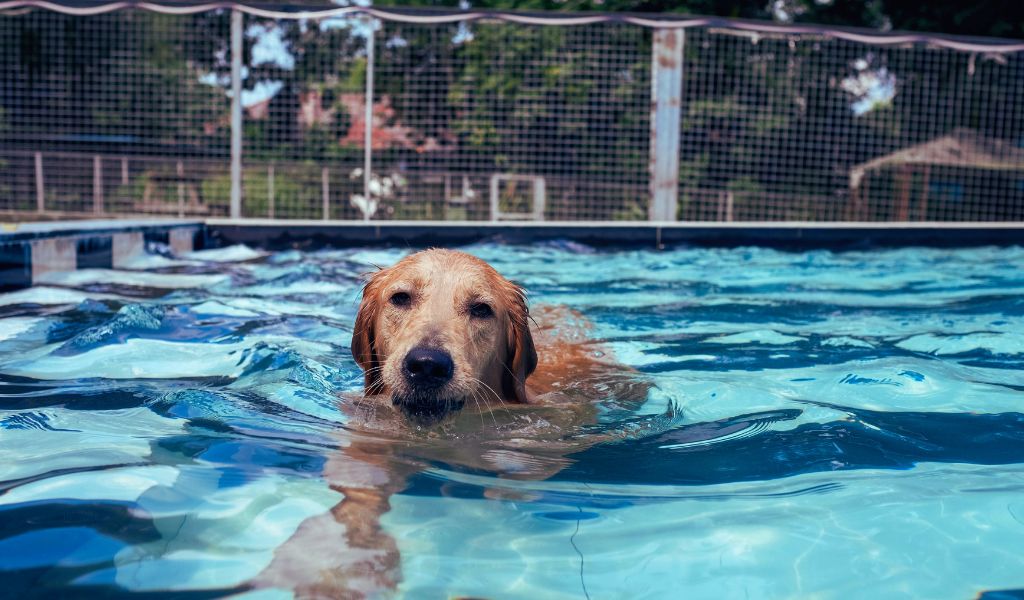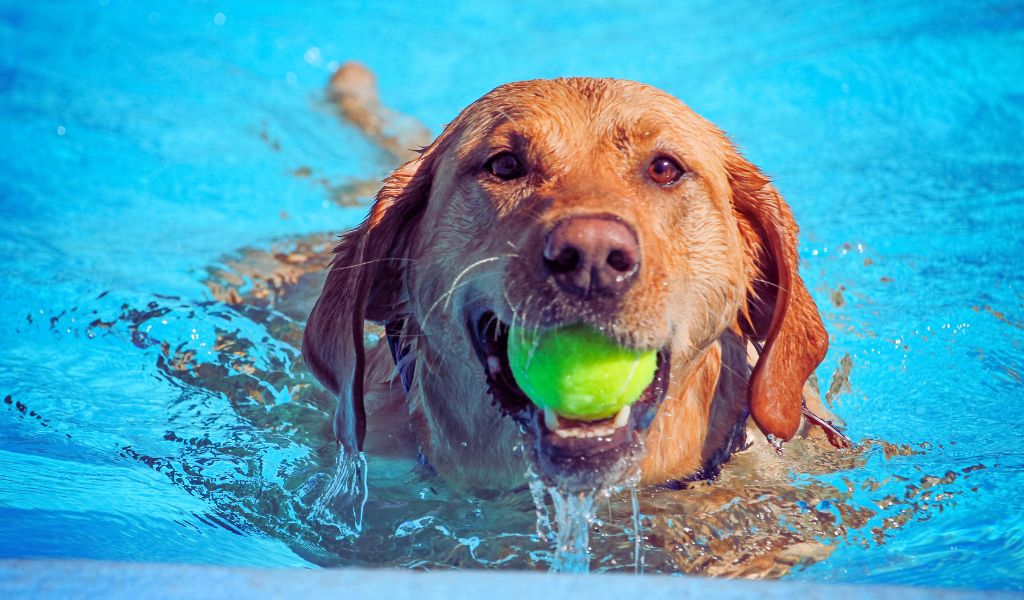Swimming is an excellent exercise for dogs, providing physical activity and mental stimulation.
However, many pet owners are concerned about the safety of their dogs swimming in chlorine pools.
This article delves into the effects of chlorine on dogs, safety precautions, and tips to ensure your dog’s swimming experience is both enjoyable and safe.
Yes, dogs can swim in chlorine pools, but there are important considerations to keep in mind. While chlorine is commonly used to keep pools clean and free of harmful bacteria, it can pose some risks to dogs. Pet owners need to be aware of how chlorine affects their pets and take appropriate measures to mitigate any negative impacts.
Effects of Chlorine on Dogs
Skin and Coat
Chlorine can have a drying effect on a dog’s skin and coat. Prolonged exposure may lead to skin irritation, itching, and a dull coat.
It is essential to rinse your dog thoroughly with fresh water after swimming to remove chlorine residue.
Eyes
Dogs’ eyes are sensitive to chlorine, similar to humans. Exposure to chlorinated water can cause redness, irritation, and discomfort.
It’s crucial to monitor your dog’s eyes for any signs of irritation and consult a veterinarian if symptoms persist.
Ingestion
While small amounts of chlorinated water are generally not harmful, excessive ingestion can lead to gastrointestinal upset.
Dogs may experience symptoms such as vomiting, diarrhoea, and dehydration. Ensure your dog has access to fresh drinking water to discourage pool water consumption.

Safety Precautions for Dogs in Chlorine Pools
Supervision
Always supervise your dog while they are in the pool. Dogs, like children, can quickly get into trouble in the water.
Ensure your dog is comfortable and confident swimming before allowing unsupervised pool time.
Fresh Water Access
Provide your dog with ample fresh water to drink before and after swimming.
This reduces the likelihood of them drinking pool water and helps keep them hydrated.
Rinse After Swimming
Rinse your dog thoroughly with fresh water after swimming to remove chlorine and other pool chemicals from their fur and skin.
This helps prevent irritation and dryness.
Ear Care
Dry your dog’s ears thoroughly after swimming to prevent ear infections.
Dogs with floppy ears are particularly susceptible to moisture-related ear issues.
Pool Safety Equipment
Consider using dog-specific pool safety equipment, such as life vests and pool ramps. Life vests provide buoyancy and support, especially for less confident swimmers.
Pool ramps help dogs exit the pool easily, reducing the risk of panic and injury.

Training Your Dog for Swimming
Gradual Introduction
Introduce your dog to the pool gradually. Start by letting them explore the shallow end and gradually encourage them to swim.
Use positive reinforcement, such as treats and praise, to create a positive association with the water.
Swim Lessons
Consider enrolling your dog in swim lessons with a professional trainer.
Professional trainers can teach your dog proper swimming techniques and water safety skills.
Health Benefits of Swimming for Dogs
Swimming is a low-impact exercise that provides numerous health benefits for dogs. It helps improve cardiovascular fitness, muscle strength, and joint mobility.
Swimming is particularly beneficial for dogs with arthritis or those recovering from surgery, as it reduces stress on the joints.
Potential Risks and How to Mitigate Them
Water Intoxication
Water intoxication occurs when a dog ingests large amounts of water, leading to an imbalance of electrolytes.
Symptoms include lethargy, bloating, vomiting, and seizures. Prevent water intoxication by limiting your dog’s swimming sessions and monitoring their water intake.
Hypothermia
Even in warm weather, prolonged exposure to water can cause hypothermia in dogs. Symptoms include shivering, lethargy, and pale gums.
Keep swimming sessions short and dry your dog thoroughly after swimming to prevent hypothermia.
FAQs: Can Dogs Swim in a Chlorine Pool?
1. Is it safe for dogs to swim in a chlorine pool?
Yes, in moderation. Most dogs can safely swim in a properly maintained chlorine pool. However, chlorine can irritate a dog’s skin, eyes, and ears if exposure is frequent or prolonged.
2. Will chlorine harm my dog if they drink the pool water?
Small amounts usually aren’t harmful, but dogs should not regularly drink pool water. Chlorine and other pool chemicals can upset the stomach and cause vomiting or diarrhoea. Always provide fresh drinking water near the pool.
3. Can chlorine affect a dog’s skin or coat?
Yes. Chlorine can dry out a dog’s skin and coat, especially in breeds with sensitive skin. Rinsing your dog with clean, fresh water after swimming helps reduce irritation.
4. What about a dog’s eyes and ears in a chlorine pool?
Chlorine may cause red or irritated eyes, and water trapped in the ears can increase the risk of ear infections. Wiping the eyes gently and drying the ears thoroughly after swimming can help.
5. Are some dogs better suited to swimming in pools than others?
Yes. Strong swimmers such as Retrievers or Spaniels often take to pools easily, but brachycephalic (flat-faced) breeds like Bulldogs or Pugs may struggle. Senior dogs or those with health issues should also be monitored closely.
6. How long should a dog stay in a chlorine pool?
Limit swimming sessions to short periods, especially for new swimmers. Ten to fifteen minutes is usually plenty, and breaks for rest and fresh water are essential.
7. Should dogs wear a life jacket in a swimming pool?
For safety, especially with inexperienced or less confident dogs, a canine life jacket is a good idea. It offers buoyancy and peace of mind.
8. Can chlorine damage a dog’s paw pads?
Chlorine itself is unlikely to damage paw pads, but constant exposure to wet, treated surfaces may lead to dryness or minor irritation. Rinsing and drying paws after swimming is recommended.
9. Are saltwater pools safer for dogs than chlorine pools?
Saltwater pools generally have lower chlorine levels and may be gentler on skin and eyes, but they still contain salt and chemicals. Dogs should still avoid drinking from them excessively.
10. What precautions should I take if I let my dog swim in my pool?
- Always supervise your dog.
- Provide fresh water for drinking.
- Rinse their coat after swimming.
- Dry their ears thoroughly.
- Limit pool time and watch for signs of fatigue or irritation.
Swimming in a chlorine pool can be a safe and enjoyable activity for dogs with the proper precautions. By understanding the effects of chlorine, implementing safety measures, and providing appropriate training, pet owners can ensure their dogs reap the benefits of swimming without adverse effects.

